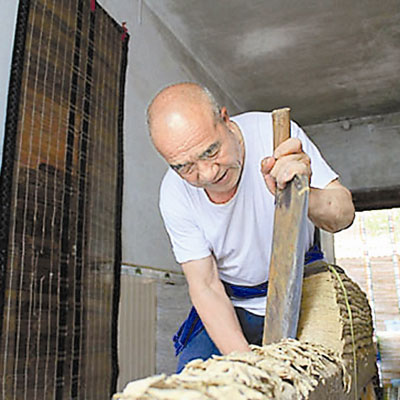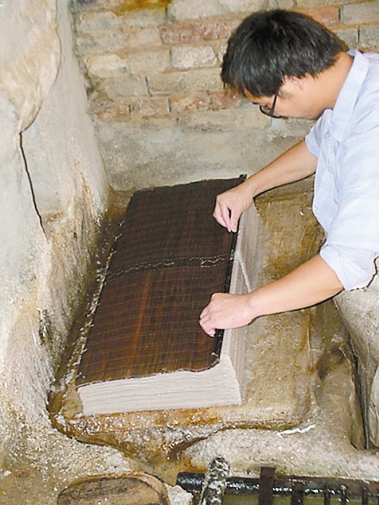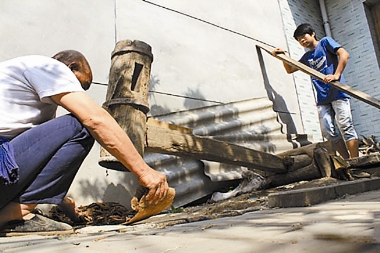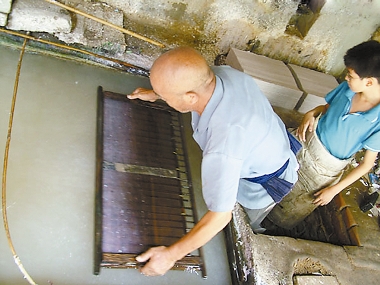



EVEN at the age of 74, Zhang Fengxue continues to make paper every day.
As a State-level inheritor of traditional Chinese papermaking techniques, Zhang is the fourth generation of his family to earn a living producing handmade paper in Beizhang, nicknamed the “Village of Paper,” located in Xi’an, capital of Northwest China’s Shaanxi Province.
Zhang demonstrates the papermaking process, which can be divided into three main phases — sorting out the fiber, making paper pulp and drying the paper — although the entire process can be further broken down into 72 steps.
This traditional handicraft that Zhang has mastered dates back 2,000 years, when Cai Lun, who invented paper and developed the paper-making process during the Han Dynasty (202 B.C.-A.D. 220), created a sheet of paper using mulberry and other plant fibers.
In 2007, the handicraft was included in the first list of intangible cultural heritage in Shaanxi Province.
“The most important advantage of my paper is that it is made from all-natural materials without adding any chemical substances,” said Zhang.
His son, Zhang Jianchang, said calligraphers and painters are the most regular buyers, as the paper is most suitable for calligraphy and Chinese ink and wash paintings.
“Because the paper is totally natural, the ink goes well with the paper and the paper is durable and can be kept for up to a thousand years,” said Zhang Jianchang, who learned the handicraft from his father.
Vanishing handicraft
According to the younger Zhang, theirs is the only family still making paper, even though more than 1,800 out of 2,300 households in the village were dedicated to making paper when the handicraft was in its heyday.
“We can only make 17,000 (US$2,667) to 18,000 yuan per year,” he said.
Meanwhile, a similar case can be found in Shanxi Province.
When Liu Longqian, an 86-year-old villager from Jiangcun Village in Shanxi, was nominated as the provincial-level inheritor of another version of traditional papermaking in 2010, he found that he was the oldest as well as the last person to master the handicraft of making hemp paper.
“I used to open my workshop and hire some workers, but operations stopped this year because I hurt my waist,” said Liu.
Unfortunately, no one has picked up where Liu left off in making hemp paper.
Jiangcun Village witnessed a boom in papermaking in the 1910s, when over one-third of 350 families ran papermaking businesses. But it could not escape the impact of commercialism that swept China in the early 1980s, as more and more people, including artisans, flocked to work in factories that promised 100 yuan per day or more.
“I could only afford to hire workers for 50 yuan each day per person at my workshop,” said Liu, adding that the lower payment and growing pressure from waning market demand made it more difficult to run such a business.
Liu also said papermaking is both energy- and time-consuming, and therefore, handmade paper has gradually become an abandoned tradition in the village.
Liu’s three sons are now seeking their dreams elsewhere. His 44-year-old daughter has stayed behind to take care of him, but she admits she has no interest in learning the handicraft.
Looking for a way
While China embraced the country’s 7th Cultural Heritage Day on Saturday, experts warned that some forms of intangible cultural heritage are facing extinction.
Xiu Jianqiao, vice director of the Intangible Cultural Heritage Protection Center of Shaanxi, said most of China’s intangible cultural heritage such as papermaking are deeply rooted in the agricultural civilization that lasted for thousands of years in China.
As China is no longer a primarily agricultural civilization, the culture that arose from it is not common or popular among the public, Xiu said.
“Obviously, handmade paper cannot compete in the market with that made by machines nowadays,” said Xiu.
He said in some Western countries, paper textbooks have been replaced with iPads, showing that culture always follows development.
“It is a failure to protect intangible cultural heritage in museums, and we should protect the public environment where the culture grows instead of just focusing on the cultural heritage itself,” said Xiu.
In contrast, Qin opera, a local form of opera in Shaanxi Province with solid foundations rooted amongst ordinary people, still shows its vitality as a form of intangible cultural heritage after hundreds of years.
Wang Zhi, curator of Xi’an Folk Art Center, said connections between the intangible cultural heritage of Qin opera and people’s daily lives are key to its survival.
“If you go around the city around dusk, you will find people in groups singing Qin opera,” Wang added. “When people take it as part of their lives, the protection work will become much easier and more effective.”(Xinhua)
|

